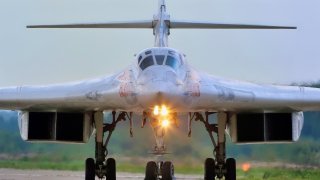Tupolev Tu-160 Blackjack: Russia's Bomber Can Hit Mach 2 and Strike Anything
The Tu-160 Blackjack is the largest and heaviest aircraft capable of sustained flight at Mach 2+, more than twice the speed of sound.
Tu-160 Blackjack Profile: Throughout the Cold War, the U.S. and Soviet Union competed against each other to develop new military technologies. Nowhere was this more apparent than in the field of military aviation.
The introduction of jet aircraft in the 1950s led to massive leaps in the capability of combat aircraft, such as flying faster than the speed of sound. The benefits of high speed became more and more apparent for bombers, in particular, as defensive jet interceptors themselves grew faster and flew higher.
As early as the 1960s, the air services of both countries realized this and set about working on a supersonic strategic bomber.
While the U.S. Air Force ended up suspending the fledgling B-1 program until the 1980s, the Tupolev design firm in the Soviet Union, in competition with two other aviation contractors, produced the Tu-160 “Blackjack,” a supersonic, swing-wing bomber.
Meet the Tu-160 Blackjack:
In 1972, the Soviet Government initiated a new contest for a bomber that could achieve speeds of Mach 2.3.
Having already designed and produced the Tu-144 supersonic passenger jet - the Soviet Union’s answer to the Concorde - Tupolev was well positioned to compete for the new bomber.
After five years of design, Tupolev unveiled a mockup of the Tu-160 however it would be another four years until the first prototype took to the skies.
Specs and capabilities:
The Tu-160 Blackjack is the largest and heaviest aircraft capable of sustained flight at Mach 2+, more than twice the speed of sound.
It has set multiple speed records for aircraft in its weight class. Its variable wings swing forward to provide more lift during slow speed flight and then pivot aft at high speeds to improve performance, just like the American B-1 supersonic strategic bomber.

Originally designed to carry and drop nuclear ordnance, the Tu-160 has an impressive payload. Its two bomb bays are capable of carrying 88,000 pounds between them. In modern use, it primarily sees work launching cruise missiles from standoff distances, to that end, it can be equipped with a rotary launcher.
In 2002, the Russian Defense Ministry decided to upgrade 15 Tu-160s. By 2006, the first overhauled airframe entered service, possessing the capability to use conventional weapons. However, the Tu-160 was not modernized with new avionics as previously intended.

It was not until 2008 that the Tu-160 was incorporated with the long-range Kh-555 conventional cruise missile.
The operational history of the Tu-160 Blackjack
First flying in 1981, the Blackjack saw limited service with the USSR before its dissolution. Only 35 were completed before production was suspended in 1992. Nineteen of them were located in the new Republic of Ukraine, which used them as a bargaining chip in economic negotiations with the Russian Federation.

In the 2000s, production was resumed on the Tu-160, and it saw combat for the first time, launching cruise missiles during the Syrian Civil War.
Since then, it has also seen service in the War in Ukraine, typically launching its missiles from Russian airspace away from potential Ukrainian reprisals.
About the Author: Maya Carlin
Maya Carlin, National Security Writer with The National Interest, is an analyst with the Center for Security Policy and a former Anna Sobol Levy Fellow at IDC Herzliya in Israel. She has by-lines in many publications, including The National Interest, Jerusalem Post, and Times of Israel. You can follow her on Twitter: @MayaCarlin.
All images are from Shutterstock.


